The global molded wood pallets market is valued at USD 2,147 million in 2025 and is set to reach USD 3,896 million by 2035, growing at a CAGR of 6.1%. The market stands at the forefront of a transformative decade that promises to redefine logistics infrastructure and material handling excellence across warehouses, manufacturing facilities, shipping companies, and distribution centers. The market's journey from USD 2,147 million in 2025 to USD 3,896 million by 2035 represents substantial growth, demonstrating the accelerating adoption of engineered wood pallet solutions and advanced molding technologies across freight transportation, industrial storage, automated handling systems, and export packaging applications.
The first half of the decade (2025-2030) will witness the market climbing from USD 2,147 million to approximately USD 2,892 million, adding USD 745 million in value, which constitutes 43% of the total forecast growth period. This phase will be characterized by the rapid adoption of automation-compatible pallet systems, driven by increasing demand for consistent dimensional accuracy and enhanced load capacity requirements worldwide. Superior strength-to-weight ratios and moisture resistance capabilities will become standard expectations rather than premium options.
The latter half (2030-2035) will witness sustained growth from USD 2,892 million to USD 3,896 million, representing an addition of USD 1,004 million or 57% of the decade's expansion. This period will be defined by mass market penetration of specialized molded pallet systems, integration with comprehensive warehouse management platforms, and seamless compatibility with existing material handling infrastructure. The market trajectory signals fundamental shifts in how logistics companies and manufacturers approach pallet standardization solutions, with participants positioned to benefit from sustained demand across multiple industrial segments.
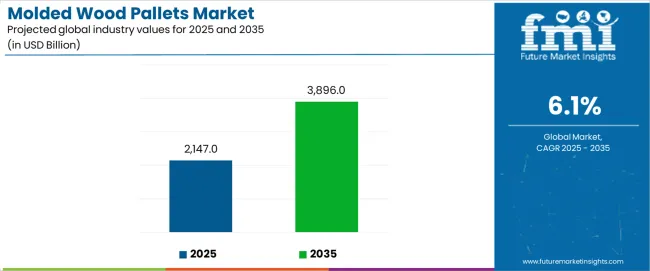
The molded wood pallets market demonstrates distinct growth phases with varying market characteristics and competitive dynamics. Between 2025 and 2030, the market progresses through its automation integration phase, expanding from USD 2,147 million to USD 2,892 million with steady annual increments averaging 6.1% growth. This period showcases the transition from conventional wooden pallets to advanced molded systems with enhanced dimensional consistency and integrated RFID compatibility becoming mainstream features.
The 2025-2030 phase adds USD 745 million to market value, representing 43% of total decade expansion. Market maturation factors include standardization of load capacity specifications, declining material costs for engineered wood production, and increasing warehouse awareness of molded pallet benefits reaching 70-75% effectiveness in automated handling applications. Competitive landscape evolution during this period features established manufacturers like Litco International and UFP Technologies expanding their product portfolios while new entrants focus on specialized lightweight solutions and enhanced durability technology.
From 2030 to 2035, market dynamics shift toward advanced customization and multi-industry deployment, with growth accelerating from USD 2,892 million to USD 3,896 million, adding USD 1,004 million or 57% of total expansion. This phase transition logic centers on universal pallet systems, integration with automated sorting equipment, and deployment across diverse logistics scenarios, becoming standard rather than specialized handling platforms. The competitive environment matures with focus shifting from basic load capacity to comprehensive performance metrics and compatibility with high-speed conveyor operations.
| Metric | Value |
|---|---|
| Market Value (2025) | USD 2,147 million |
| Market Forecast (2035) | USD 3,896 million |
| Growth Rate | 6.10% CAGR |
| Leading Material | Pressed Wood Fiber |
| Primary Application | Manufacturing & Industrial |
The market demonstrates strong fundamentals with pressed wood fiber pallets capturing a dominant share through superior load distribution and precision manufacturing capabilities. Manufacturing and industrial applications drive primary demand, supported by increasing automation requirements and standardized handling solutions. Geographic expansion remains concentrated in developed markets with established logistics infrastructure, while emerging economies show accelerating adoption rates driven by warehouse modernization projects and rising export activity.
The molded wood pallets market represents a compelling intersection of logistics optimization, material engineering, and automated handling management. With robust growth projected from USD 2,147 million in 2025 to USD 3,896 million by 2035 at a 6.10% CAGR, this market is driven by increasing warehouse automation trends, export packaging requirements, and commercial demand for high-quality standardized handling formats.
The market's expansion reflects a fundamental shift in how logistics providers and manufacturers approach pallet standardization infrastructure. Strong growth opportunities exist across diverse applications, from manufacturing facilities requiring consistent load platforms to distribution centers demanding automation-compatible solutions. Geographic expansion is particularly pronounced in Asia-Pacific markets, led by China (7.2% CAGR) and India (6.8% CAGR), while established markets in North America and Europe drive innovation and specialized segment development.
The dominance of pressed wood fiber materials and manufacturing applications underscores the importance of proven engineering technology and load consistency in driving adoption. Dimensional accuracy and weight optimization remain key challenges, creating opportunities for companies that can deliver reliable performance while maintaining cost efficiency.
Market expansion rests on three fundamental shifts driving adoption across logistics and manufacturing sectors. Warehouse automation creates compelling advantages through molded pallet systems that provide comprehensive dimensional consistency with enhanced load capacity, enabling facilities to optimize conveyor systems and maintain handling efficiency while justifying capital investments over conventional wooden alternatives. Supply chain optimization accelerates as logistics providers worldwide seek standardized handling solutions that deliver reliable performance across diverse transportation environments, enabling cost reduction that aligns with operational excellence expectations and maximizes throughput efficiency. Manufacturing operations enhancement drives adoption from production facilities requiring consistent material handling platforms that maximize productivity per handling cycle while maintaining quality standards during storage and distribution operations.
However, growth faces headwinds from material cost variations that differ across wood fiber suppliers regarding raw material availability and processing capabilities, potentially limiting performance reliability in cost-sensitive industrial categories. Dimensional tolerance requirements also persist regarding precision specifications and load distribution standards that may increase manufacturing complexity in markets with demanding weight limitations.
Primary Classification: The market segments by material into pressed wood fiber, recycled wood composite, engineered wood particles, and laminated wood categories, representing the evolution from basic molded formats to precision-engineered platforms for comprehensive logistics operations.
Secondary Breakdown: Application segmentation divides the market into manufacturing & industrial, food & beverage, pharmaceutical, automotive, retail & distribution, and others sectors, reflecting distinct requirements for load capacity, dimensional accuracy, and environmental resistance.
Regional Classification: Geographic distribution covers Asia Pacific, North America, Europe, Latin America, and the Middle East & Africa, with developed markets leading automation adoption while emerging economies show accelerating growth patterns driven by export infrastructure development programs.
The segmentation structure reveals technology progression from standard molded containers toward integrated handling platforms with enhanced load distribution and automation compatibility capabilities, while application diversity spans from manufacturing operations to specialized transport requiring comprehensive standardization solutions and precision handling systems.
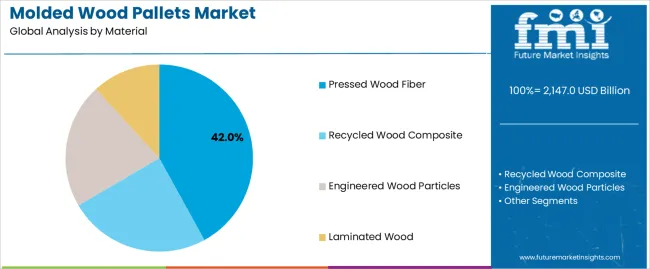
Pressed wood fiber segment is estimated to account for 42% of the molded wood pallets market share in 2025. The segment's leading position stems from its fundamental role as a critical component in load distribution applications and its extensive use across multiple manufacturing and logistics sectors. Pressed wood fiber's dominance is attributed to its superior dimensional consistency, including uniform density distribution, excellent load-bearing characteristics, and balanced weight properties that make it indispensable for automated handling operations.
Market Position: Pressed wood fiber systems command the leading position in the molded wood pallets market through advanced manufacturing technologies, including comprehensive compression control, uniform material distribution, and reliable structural performance that enable facilities to deploy pallets across diverse industrial applications.
Value Drivers: The segment benefits from material efficiency advantages that provide exceptional strength-to-weight ratios without requiring specialized handling protocols. Efficient processing capabilities enable deployment in manufacturing operations, warehouse facilities, and transportation applications where cost-effectiveness and load reliability represent critical selection requirements.
Competitive Advantages: Pressed wood fiber systems differentiate through excellent dimensional accuracy, proven durability characteristics, and compatibility with standard handling equipment that enhance load stability while maintaining economical pallet profiles suitable for diverse industrial applications.
Key market characteristics:
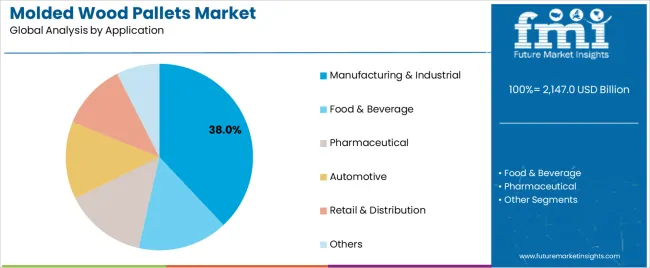
Manufacturing & industrial segment is projected to hold 38% of the molded wood pallets market share in 2025. The segment's market leadership is driven by the extensive use of molded pallets in production facilities, assembly operations, warehouse storage, and material handling systems, where pallets serve as both load platforms and process integration tools. The manufacturing industry's consistent investment in automation efficiency supports the segment's dominant position.
Market Context: Manufacturing and industrial applications dominate the market due to widespread adoption of standardized handling systems and increasing focus on operational efficiency, productivity enhancement, and quality consistency that extend production value while maintaining dimensional reliability.
Appeal Factors: Manufacturing operators prioritize load capacity consistency, dimensional accuracy, and integration with existing handling equipment that enable coordinated deployment across multiple production points. The segment benefits from substantial industrial growth and automation standards that emphasize reliable material handling platforms for efficient operations.
Growth Drivers: Factory modernization programs incorporate molded pallets as standard handling tools for assembly line integration. At the same time, warehouse automation initiatives are increasing demand for precision-manufactured platforms that comply with equipment specifications and enhance operational efficiency programs.
Market Challenges: Equipment compatibility variations and load specification requirements may limit deployment flexibility in ultra-high-capacity operations or extreme precision-sensitive scenarios.
Application dynamics include:
Growth Accelerators: Warehouse automation drives primary adoption as molded pallet systems provide exceptional dimensional consistency that enables precision handling without compromising load stability, supporting facility efficiency enhancement and productivity optimization that require standardized material handling formats. Industrial modernization accelerates market growth as manufacturers seek reliable handling platforms that maintain structural integrity during transport while enhancing operational flexibility through engineered container design. Logistics optimization increases worldwide, creating sustained demand for precision handling systems that complement supply chain efficiency and provide competitive advantages in load standardization.
Growth Inhibitors: Material cost fluctuations challenge procurement across wood fiber suppliers regarding raw material availability and processing efficiency, which may limit market penetration and profitability in price-sensitive categories with demanding cost requirements. Dimensional tolerance specifications persist regarding precision manufacturing and quality control procedures that may increase production costs in applications with strict accuracy specifications. Market fragmentation across multiple load capacities and size configurations creates compatibility concerns between different handling equipment and existing facility infrastructure.
Market Evolution Patterns: Adoption accelerates in manufacturing and logistics sectors where handling consistency justifies system investments, with geographic concentration in developed markets transitioning toward mainstream adoption in emerging economies driven by export infrastructure development and industrial facility expansion. Technology development focuses on enhanced load distribution, improved dimensional accuracy, and integration with automated handling systems that optimize operational efficiency and facility productivity. The market could face disruption if alternative pallet technologies or handling innovations significantly challenge molded wood advantages in logistics applications.
The molded wood pallets market demonstrates varied regional dynamics with Growth Leaders including China (7.2% CAGR) and India (6.8% CAGR) driving expansion through industrial modernization and export infrastructure development. Steady Performers encompass the U.S. (6.5% CAGR), Germany (5.8% CAGR), and Japan (5.3% CAGR), benefiting from established manufacturing sectors and automation adoption.

| Country | CAGR (2025-2035) |
|---|---|
| China | 7.2% |
| India | 6.8% |
| U.S. | 6.5% |
| Germany | 5.8% |
| Japan | 5.3% |
Regional synthesis reveals Asia-Pacific markets leading growth through manufacturing expansion and export infrastructure development, while European countries maintain steady expansion supported by established logistics networks and precision manufacturing requirements. North American markets show strong growth driven by warehouse automation proliferation and industrial efficiency applications.
China establishes regional leadership through explosive manufacturing expansion and comprehensive logistics infrastructure modernization, integrating advanced molded pallet systems as standard components in factory operations and export packaging applications. The country's 7.2% CAGR through 2035 reflects industrial facility evolution promoting automated handling adoption and domestic production activity that mandate the use of standardized handling platforms in manufacturing operations. Growth concentrates in major industrial centers, including Guangzhou, Shanghai, and Shenzhen, where manufacturing facilities showcase integrated pallet systems that appeal to export-oriented companies seeking reliable handling standards and international logistics compatibility.
Chinese manufacturers are developing innovative molded pallet solutions that combine local production advantages with international handling specifications, including enhanced load distribution and advanced dimensional accuracy capabilities.
Strategic Market Indicators:
The Indian market emphasizes manufacturing applications, including rapid industrial development and comprehensive logistics modernization that increasingly incorporates molded pallets for material handling and export packaging applications. The country is projected to show a 6.8% CAGR through 2035, driven by massive manufacturing activity under industrial development initiatives and commercial demand for cost-effective, high-quality handling systems. Indian manufacturers prioritize efficiency optimization with molded pallets delivering standardized handling through economical platform usage and reliable load distribution capabilities.
Technology deployment channels include major manufacturing companies, logistics providers, and export facilities that support high-volume usage for domestic and international applications.
Performance Metrics:
The U.S. market emphasizes advanced pallet features, including innovative handling technologies and integration with comprehensive warehouse platforms that manage material flow, inventory control, and efficiency optimization applications through unified handling systems. The country is projected to show a 6.5% CAGR through 2035, driven by warehouse expansion under logistics modernization trends and commercial demand for premium, reliable handling systems. American facilities prioritize operational efficiency with molded pallets delivering comprehensive load management through refined dimensional control and automation compatibility.
Technology deployment channels include major logistics companies, manufacturing equipment suppliers, and specialized pallet manufacturers that support custom development for high-performance operations.
Performance Metrics:
In Munich, Stuttgart, and Hamburg, German manufacturers and logistics providers are implementing advanced molded pallet systems to enhance handling capabilities and support industrial efficiency optimization that aligns with manufacturing protocols and quality standards. The German market demonstrates sustained growth with a 5.8% CAGR through 2035, driven by traditional manufacturing innovation programs and industrial automation investments that emphasize precision handling systems for production and distribution applications. German manufacturing facilities are prioritizing molded pallet systems that provide exceptional dimensional accuracy while maintaining compliance with industrial standards and minimizing handling variation, particularly important in automotive production and precision manufacturing facilities.
Market expansion benefits from engineering excellence programs that mandate enhanced precision in handling specifications, creating sustained demand across Germany's manufacturing and logistics sectors, where dimensional consistency and system reliability represent critical requirements.
Strategic Market Indicators:
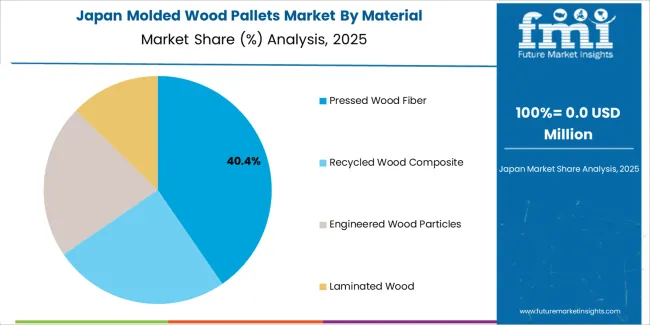
Japan's sophisticated manufacturing market demonstrates meticulous molded pallet deployment, growing at 5.3% CAGR, with documented operational excellence in handling optimization and industrial efficiency applications through integration with existing automation systems and quality control infrastructure. The country leverages engineering expertise in precision manufacturing and dimensional control to maintain market leadership. Industrial centers, including Tokyo, Osaka, and Nagoya, showcase advanced installations where molded pallet systems integrate with comprehensive manufacturing platforms and handling systems to optimize productivity and operational consistency.
Japanese manufacturers prioritize precision engineering and dimensional reliability in product development, creating demand for premium molded pallet systems with advanced features, including ultra-precise load distribution and integration with automated handling protocols. The market benefits from established manufacturing infrastructure and willingness to invest in specialized handling technologies that provide superior efficiency retention and operational compliance.
Market Intelligence Brief:
The molded wood pallets market in Europe is projected to grow from USD 643 million in 2025 to USD 1,089 million by 2035, registering a CAGR of 5.4% over the forecast period. Germany is expected to maintain its leadership position with a 32.1% market share in 2025, declining slightly to 31.8% by 2035, supported by its manufacturing excellence and major industrial centers, including Bavaria and North Rhine-Westphalia.
United Kingdom follows with a 21.7% share in 2025, projected to reach 22.2% by 2035, driven by comprehensive logistics modernization and warehouse automation adoption. France holds a 18.9% share in 2025, expected to maintain 19.3% by 2035 through established manufacturing sectors and export packaging adoption. Italy commands a 13.2% share, while Netherlands accounts for 8.4% in 2025. The Rest of Europe region is anticipated to gain momentum, expanding its collective share from 5.7% to 6.1% by 2035, attributed to increasing industrial development in Eastern European countries and emerging Nordic manufacturing brands implementing precision handling programs.
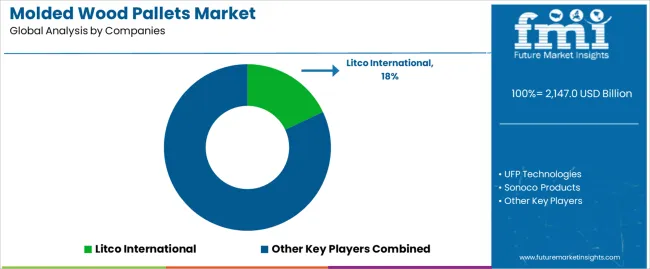
The molded wood pallets market operates with moderate concentration, featuring approximately 22-28 participants, where leading companies control roughly 45-52% of the global market share through established manufacturing networks and comprehensive engineering capabilities. Competition emphasizes load capacity performance, dimensional accuracy, and automation compatibility rather than price-based rivalry.
Market leaders encompass Litco International, UFP Technologies, and Sonoco Products, which maintain competitive advantages through extensive molding manufacturing expertise, global distribution networks, and comprehensive technical support capabilities that create customer loyalty and support industrial requirements. These companies leverage decades of material handling experience and ongoing engineering technology investments to develop advanced molded pallet systems with exceptional load distribution and dimensional consistency features. Litco International leads with 18% share.
Specialty challengers include CABKA Group, Schoeller Allibert, and Pallet Management Group, which compete through specialized industrial innovation focus and efficient handling solutions that appeal to manufacturers seeking premium standardization formats and custom engineering flexibility. These companies differentiate through design engineering emphasis and specialized industrial application focus.
Market dynamics favor participants that combine reliable load performance with advanced automation support, including dimensional precision and handling compatibility. Competitive pressure intensifies as traditional wooden pallet manufacturers expand into molded systems. At the same time, specialized material handling suppliers challenge established players through innovative compression technologies and cost-effective production targeting emerging industrial segments.
| Item | Value |
|---|---|
| Quantitative Units | USD 2,147 million |
| Material | Pressed Wood Fiber, Recycled Wood Composite, Engineered Wood Particles, Laminated Wood |
| Application | Manufacturing & Industrial, Food & Beverage, Pharmaceutical, Automotive, Retail & Distribution, Others |
| Regions Covered | Asia Pacific, North America, Europe, Latin America, Middle East & Africa |
| Countries Covered | U.S., Germany, Japan, China, India, and 25+ additional countries |
| Key Companies Profiled | Litco International, UFP Technologies, Sonoco Products, CABKA Group, Schoeller Allibert, Pallet Management Group |
| Additional Attributes | Dollar sales by material and application categories, regional adoption trends across Asia Pacific, North America, and Europe, competitive landscape with pallet manufacturers and material handling suppliers, industrial preferences for load capacity and dimensional accuracy, integration with automated handling equipment and storage systems, innovations in compression molding technology and weight optimization, and development of specialized handling solutions with enhanced durability capabilities and automation-friendly features |
The global molded wood pallets market is estimated to be valued at USD 2,147.0 billion in 2025.
The market size for the molded wood pallets market is projected to reach USD 3,896.0 billion by 2035.
The molded wood pallets market is expected to grow at a 6.1% CAGR between 2025 and 2035.
The key product types in molded wood pallets market are pressed wood fiber, recycled wood composite, engineered wood particles and laminated wood.
In terms of application, manufacturing & industrial segment to command 38.0% share in the molded wood pallets market in 2025.






Full Research Suite comprises of:
Market outlook & trends analysis
Interviews & case studies
Strategic recommendations
Vendor profiles & capabilities analysis
5-year forecasts
8 regions and 60+ country-level data splits
Market segment data splits
12 months of continuous data updates
DELIVERED AS:
PDF EXCEL ONLINE
Competitive Overview of Molded Wood Pallets Market Share
Molded Fiber Egg Packaging Market Forecast and Outlook 2025 to 2035
Molded Fiber Bowl Market Size and Share Forecast Outlook 2025 to 2035
Molded Fiber Pulp Packaging Industry Analysis in Australia and New Zealand Forecast Outlook 2025 to 2035
Molded Fiber Pulp Packaging Market Size and Share Forecast Outlook 2025 to 2035
Molded Fiber Packaging Market Size and Share Forecast Outlook 2025 to 2035
Molded Fiber Pulp Cap Market Size and Share Forecast Outlook 2025 to 2035
Molded Fiber Pulp Packaging Market Size and Share Forecast Outlook 2025 to 2035
Molded FRP Grating Market Size and Share Forecast Outlook 2025 to 2035
Molded Foam Market Size and Share Forecast Outlook 2025 to 2035
Molded Fiber Cup Market Size and Share Forecast Outlook 2025 to 2035
Molded Pulp Packaging Market Size and Share Forecast Outlook 2025 to 2035
Molded Pulp Basket Market Size and Share Forecast Outlook 2025 to 2035
Molded Fiber Wine Packs Market Size and Share Forecast Outlook 2025 to 2035
Molded Underfill Material Market Size and Share Forecast Outlook 2025 to 2035
Molded Fiber Pulp Edge Protectors Market Size and Share Forecast Outlook 2025 to 2035
Molded Fiber End Caps Market Size and Share Forecast Outlook 2025 to 2035
Molded Fiber Containers Market Size and Share Forecast Outlook 2025 to 2035
Molded Fiber Pulp Packaging industry Analysis in USA and Canada - Size, Share, and Forecast Outlook 2025 to 2035
Molded Pulp Packaging Machines Market Analysis - Growth & Forecast 2025 to 2035

Thank you!
You will receive an email from our Business Development Manager. Please be sure to check your SPAM/JUNK folder too.
Chat With
MaRIA